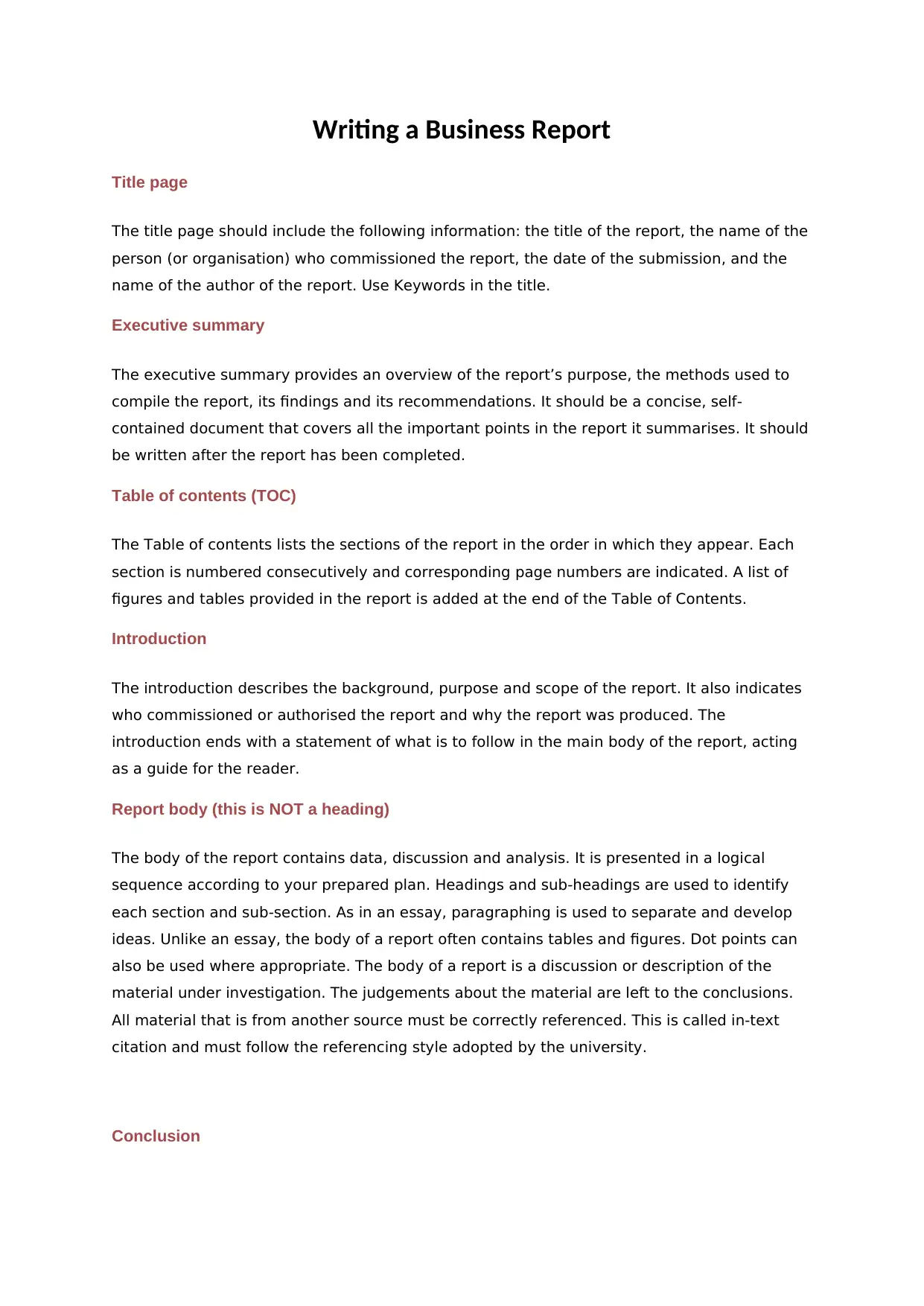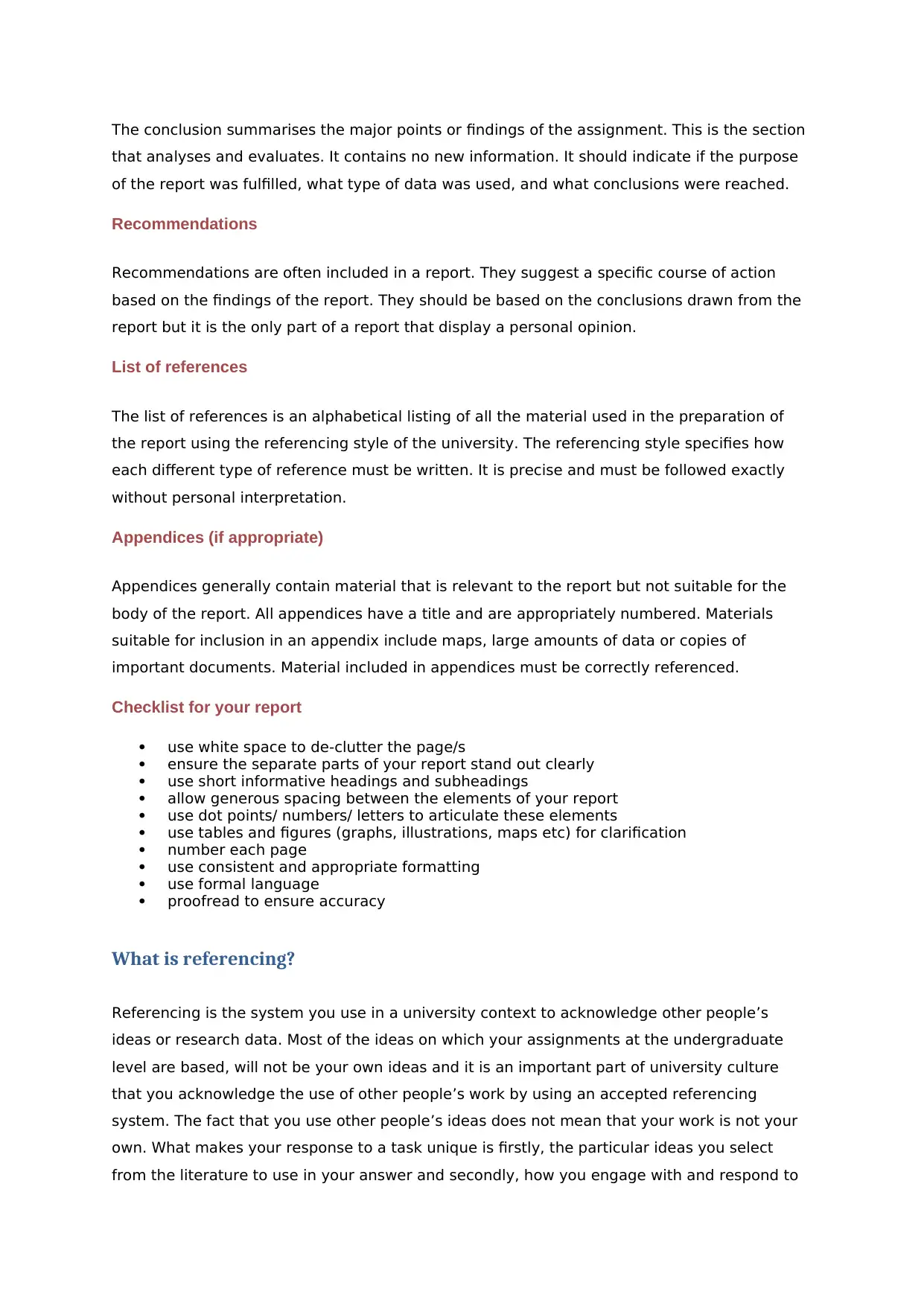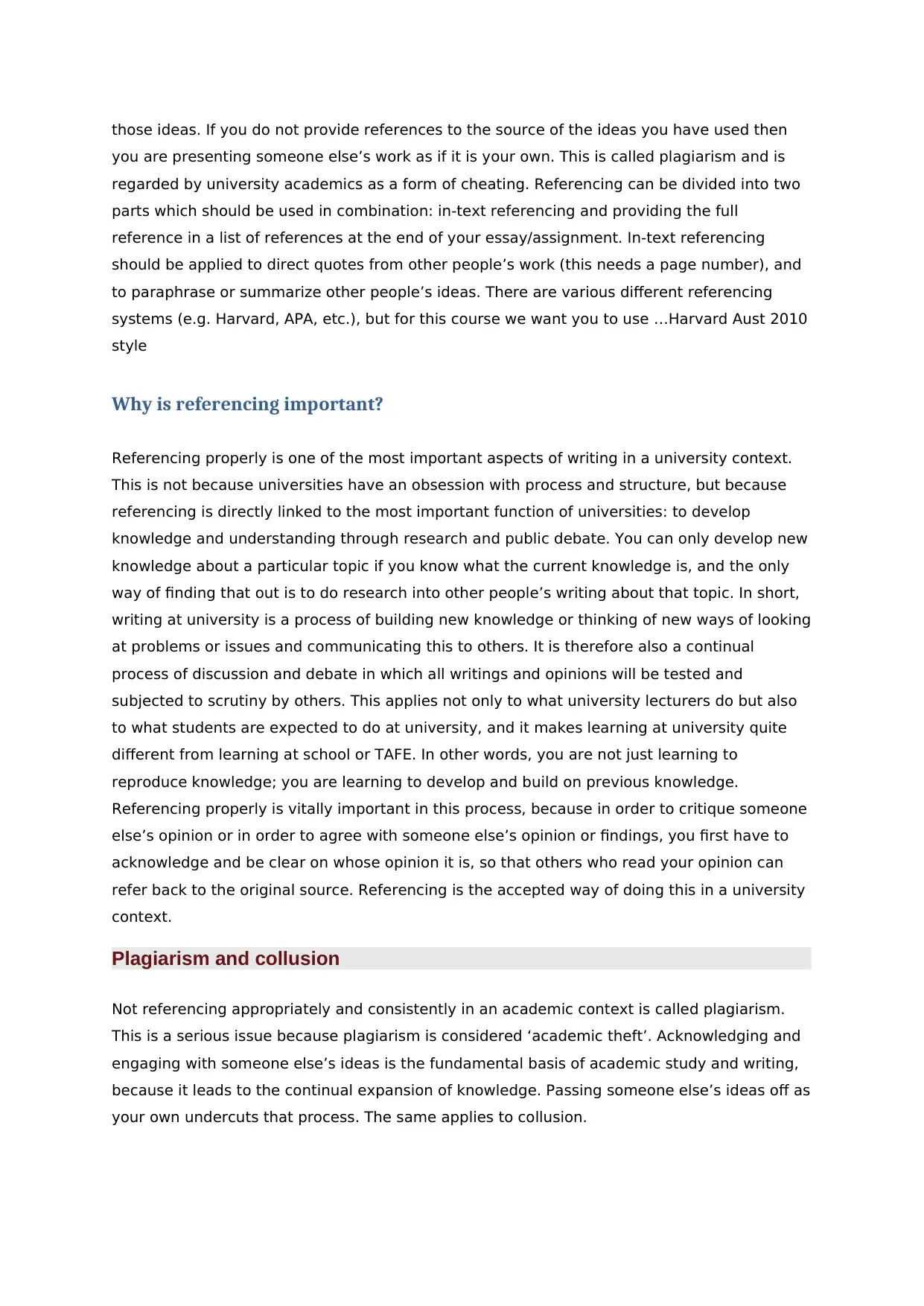Business Report: Structure, Referencing, and Formatting Guide
VerifiedAdded on 2019/10/30
|4
|1317
|79
Report
AI Summary
This document provides a comprehensive guide to structuring a business report. It details the essential components such as the title page, executive summary, table of contents, introduction, body (with headings, subheadings, and referencing), conclusion, recommendations, and list of references. The report emphasizes the importance of proper referencing, specifically Harvard referencing, and explains the consequences of plagiarism. It also includes a checklist for report writing, covering aspects like formatting, use of white space, and the inclusion of tables and figures. The document clarifies the purpose of referencing in academic writing and the significance of acknowledging sources to build new knowledge and avoid plagiarism.

Writing a Business Report
Title page
The title page should include the following information: the title of the report, the name of the
person (or organisation) who commissioned the report, the date of the submission, and the
name of the author of the report. Use Keywords in the title.
Executive summary
The executive summary provides an overview of the report’s purpose, the methods used to
compile the report, its findings and its recommendations. It should be a concise, self-
contained document that covers all the important points in the report it summarises. It should
be written after the report has been completed.
Table of contents (TOC)
The Table of contents lists the sections of the report in the order in which they appear. Each
section is numbered consecutively and corresponding page numbers are indicated. A list of
figures and tables provided in the report is added at the end of the Table of Contents.
Introduction
The introduction describes the background, purpose and scope of the report. It also indicates
who commissioned or authorised the report and why the report was produced. The
introduction ends with a statement of what is to follow in the main body of the report, acting
as a guide for the reader.
Report body (this is NOT a heading)
The body of the report contains data, discussion and analysis. It is presented in a logical
sequence according to your prepared plan. Headings and sub-headings are used to identify
each section and sub-section. As in an essay, paragraphing is used to separate and develop
ideas. Unlike an essay, the body of a report often contains tables and figures. Dot points can
also be used where appropriate. The body of a report is a discussion or description of the
material under investigation. The judgements about the material are left to the conclusions.
All material that is from another source must be correctly referenced. This is called in-text
citation and must follow the referencing style adopted by the university.
Conclusion
Title page
The title page should include the following information: the title of the report, the name of the
person (or organisation) who commissioned the report, the date of the submission, and the
name of the author of the report. Use Keywords in the title.
Executive summary
The executive summary provides an overview of the report’s purpose, the methods used to
compile the report, its findings and its recommendations. It should be a concise, self-
contained document that covers all the important points in the report it summarises. It should
be written after the report has been completed.
Table of contents (TOC)
The Table of contents lists the sections of the report in the order in which they appear. Each
section is numbered consecutively and corresponding page numbers are indicated. A list of
figures and tables provided in the report is added at the end of the Table of Contents.
Introduction
The introduction describes the background, purpose and scope of the report. It also indicates
who commissioned or authorised the report and why the report was produced. The
introduction ends with a statement of what is to follow in the main body of the report, acting
as a guide for the reader.
Report body (this is NOT a heading)
The body of the report contains data, discussion and analysis. It is presented in a logical
sequence according to your prepared plan. Headings and sub-headings are used to identify
each section and sub-section. As in an essay, paragraphing is used to separate and develop
ideas. Unlike an essay, the body of a report often contains tables and figures. Dot points can
also be used where appropriate. The body of a report is a discussion or description of the
material under investigation. The judgements about the material are left to the conclusions.
All material that is from another source must be correctly referenced. This is called in-text
citation and must follow the referencing style adopted by the university.
Conclusion
Paraphrase This Document
Need a fresh take? Get an instant paraphrase of this document with our AI Paraphraser

The conclusion summarises the major points or findings of the assignment. This is the section
that analyses and evaluates. It contains no new information. It should indicate if the purpose
of the report was fulfilled, what type of data was used, and what conclusions were reached.
Recommendations
Recommendations are often included in a report. They suggest a specific course of action
based on the findings of the report. They should be based on the conclusions drawn from the
report but it is the only part of a report that display a personal opinion.
List of references
The list of references is an alphabetical listing of all the material used in the preparation of
the report using the referencing style of the university. The referencing style specifies how
each different type of reference must be written. It is precise and must be followed exactly
without personal interpretation.
Appendices (if appropriate)
Appendices generally contain material that is relevant to the report but not suitable for the
body of the report. All appendices have a title and are appropriately numbered. Materials
suitable for inclusion in an appendix include maps, large amounts of data or copies of
important documents. Material included in appendices must be correctly referenced.
Checklist for your report
use white space to de-clutter the page/s
ensure the separate parts of your report stand out clearly
use short informative headings and subheadings
allow generous spacing between the elements of your report
use dot points/ numbers/ letters to articulate these elements
use tables and figures (graphs, illustrations, maps etc) for clarification
number each page
use consistent and appropriate formatting
use formal language
proofread to ensure accuracy
What is referencing?
Referencing is the system you use in a university context to acknowledge other people’s
ideas or research data. Most of the ideas on which your assignments at the undergraduate
level are based, will not be your own ideas and it is an important part of university culture
that you acknowledge the use of other people’s work by using an accepted referencing
system. The fact that you use other people’s ideas does not mean that your work is not your
own. What makes your response to a task unique is firstly, the particular ideas you select
from the literature to use in your answer and secondly, how you engage with and respond to
that analyses and evaluates. It contains no new information. It should indicate if the purpose
of the report was fulfilled, what type of data was used, and what conclusions were reached.
Recommendations
Recommendations are often included in a report. They suggest a specific course of action
based on the findings of the report. They should be based on the conclusions drawn from the
report but it is the only part of a report that display a personal opinion.
List of references
The list of references is an alphabetical listing of all the material used in the preparation of
the report using the referencing style of the university. The referencing style specifies how
each different type of reference must be written. It is precise and must be followed exactly
without personal interpretation.
Appendices (if appropriate)
Appendices generally contain material that is relevant to the report but not suitable for the
body of the report. All appendices have a title and are appropriately numbered. Materials
suitable for inclusion in an appendix include maps, large amounts of data or copies of
important documents. Material included in appendices must be correctly referenced.
Checklist for your report
use white space to de-clutter the page/s
ensure the separate parts of your report stand out clearly
use short informative headings and subheadings
allow generous spacing between the elements of your report
use dot points/ numbers/ letters to articulate these elements
use tables and figures (graphs, illustrations, maps etc) for clarification
number each page
use consistent and appropriate formatting
use formal language
proofread to ensure accuracy
What is referencing?
Referencing is the system you use in a university context to acknowledge other people’s
ideas or research data. Most of the ideas on which your assignments at the undergraduate
level are based, will not be your own ideas and it is an important part of university culture
that you acknowledge the use of other people’s work by using an accepted referencing
system. The fact that you use other people’s ideas does not mean that your work is not your
own. What makes your response to a task unique is firstly, the particular ideas you select
from the literature to use in your answer and secondly, how you engage with and respond to

those ideas. If you do not provide references to the source of the ideas you have used then
you are presenting someone else’s work as if it is your own. This is called plagiarism and is
regarded by university academics as a form of cheating. Referencing can be divided into two
parts which should be used in combination: in-text referencing and providing the full
reference in a list of references at the end of your essay/assignment. In-text referencing
should be applied to direct quotes from other people’s work (this needs a page number), and
to paraphrase or summarize other people’s ideas. There are various different referencing
systems (e.g. Harvard, APA, etc.), but for this course we want you to use …Harvard Aust 2010
style
Why is referencing important?
Referencing properly is one of the most important aspects of writing in a university context.
This is not because universities have an obsession with process and structure, but because
referencing is directly linked to the most important function of universities: to develop
knowledge and understanding through research and public debate. You can only develop new
knowledge about a particular topic if you know what the current knowledge is, and the only
way of finding that out is to do research into other people’s writing about that topic. In short,
writing at university is a process of building new knowledge or thinking of new ways of looking
at problems or issues and communicating this to others. It is therefore also a continual
process of discussion and debate in which all writings and opinions will be tested and
subjected to scrutiny by others. This applies not only to what university lecturers do but also
to what students are expected to do at university, and it makes learning at university quite
different from learning at school or TAFE. In other words, you are not just learning to
reproduce knowledge; you are learning to develop and build on previous knowledge.
Referencing properly is vitally important in this process, because in order to critique someone
else’s opinion or in order to agree with someone else’s opinion or findings, you first have to
acknowledge and be clear on whose opinion it is, so that others who read your opinion can
refer back to the original source. Referencing is the accepted way of doing this in a university
context.
Plagiarism and collusion
Not referencing appropriately and consistently in an academic context is called plagiarism.
This is a serious issue because plagiarism is considered ‘academic theft’. Acknowledging and
engaging with someone else’s ideas is the fundamental basis of academic study and writing,
because it leads to the continual expansion of knowledge. Passing someone else’s ideas off as
your own undercuts that process. The same applies to collusion.
you are presenting someone else’s work as if it is your own. This is called plagiarism and is
regarded by university academics as a form of cheating. Referencing can be divided into two
parts which should be used in combination: in-text referencing and providing the full
reference in a list of references at the end of your essay/assignment. In-text referencing
should be applied to direct quotes from other people’s work (this needs a page number), and
to paraphrase or summarize other people’s ideas. There are various different referencing
systems (e.g. Harvard, APA, etc.), but for this course we want you to use …Harvard Aust 2010
style
Why is referencing important?
Referencing properly is one of the most important aspects of writing in a university context.
This is not because universities have an obsession with process and structure, but because
referencing is directly linked to the most important function of universities: to develop
knowledge and understanding through research and public debate. You can only develop new
knowledge about a particular topic if you know what the current knowledge is, and the only
way of finding that out is to do research into other people’s writing about that topic. In short,
writing at university is a process of building new knowledge or thinking of new ways of looking
at problems or issues and communicating this to others. It is therefore also a continual
process of discussion and debate in which all writings and opinions will be tested and
subjected to scrutiny by others. This applies not only to what university lecturers do but also
to what students are expected to do at university, and it makes learning at university quite
different from learning at school or TAFE. In other words, you are not just learning to
reproduce knowledge; you are learning to develop and build on previous knowledge.
Referencing properly is vitally important in this process, because in order to critique someone
else’s opinion or in order to agree with someone else’s opinion or findings, you first have to
acknowledge and be clear on whose opinion it is, so that others who read your opinion can
refer back to the original source. Referencing is the accepted way of doing this in a university
context.
Plagiarism and collusion
Not referencing appropriately and consistently in an academic context is called plagiarism.
This is a serious issue because plagiarism is considered ‘academic theft’. Acknowledging and
engaging with someone else’s ideas is the fundamental basis of academic study and writing,
because it leads to the continual expansion of knowledge. Passing someone else’s ideas off as
your own undercuts that process. The same applies to collusion.
⊘ This is a preview!⊘
Do you want full access?
Subscribe today to unlock all pages.

Trusted by 1+ million students worldwide

Ref: http://www.usq.edu.au/extrafiles/ltsu/templates/ltsu_templates/ltsu_index.htm
1 out of 4
Related Documents
Your All-in-One AI-Powered Toolkit for Academic Success.
+13062052269
info@desklib.com
Available 24*7 on WhatsApp / Email
![[object Object]](/_next/static/media/star-bottom.7253800d.svg)
Unlock your academic potential
Copyright © 2020–2025 A2Z Services. All Rights Reserved. Developed and managed by ZUCOL.





